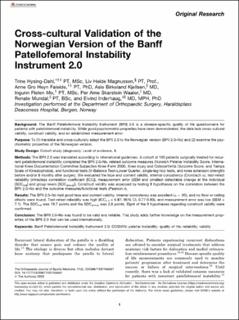| dc.contributor.author | Hysing-Dahl, Trine | |
| dc.contributor.author | Magnussen, Liv Heide | |
| dc.contributor.author | Faleide, Anne Gro Heyn | |
| dc.contributor.author | Kjellsen, Asle | |
| dc.contributor.author | Mo, Ingunn Fleten | |
| dc.contributor.author | Waaler, Per Arne Skarstein | |
| dc.contributor.author | Mundal, Renate | |
| dc.contributor.author | Inderhaug, Eivind | |
| dc.date.accessioned | 2023-09-08T08:26:04Z | |
| dc.date.available | 2023-09-08T08:26:04Z | |
| dc.date.created | 2023-06-12T15:03:42Z | |
| dc.date.issued | 2023 | |
| dc.identifier.citation | Orthopaedic Journal of Sports Medicine (OJSM). 2023, 11 (5), . | en_US |
| dc.identifier.issn | 2325-9671 | |
| dc.identifier.uri | https://hdl.handle.net/11250/3088133 | |
| dc.description.abstract | Background: The Banff Patellofemoral Instability Instrument (BPII) 2.0 is a disease-specific quality of life questionnaire for patients with patellofemoral instability. While good psychometric properties have been demonstrated, the data lack cross-cultural validity, construct validity, and an established measurement error. Purpose: To (1) translate and cross-culturally adapt the BPII 2.0 to the Norwegian version (BPII 2.0–No) and (2) examine the psychometric properties of the Norwegian version. Study Design: Cohort study (diagnosis); Level of evidence, 3. Methods: The BPII 2.0 was translated according to international guidelines. A cohort of 100 patients surgically treated for recurrent patellofemoral instability completed the BPII 2.0–No, related outcome measures (Norwich Patellar Instability Score, International Knee Documentation Committee Subjective Knee Form 2000, Knee injury and Osteoarthritis Outcome Score, and Tampa Scale of Kinesiophobia), and functional tests (Y-Balance Test–Lower Quarter, single-leg hop tests, and knee extension strength) before and/or 6 months after surgery. We evaluated the face and content validity, internal consistency (Cronbach α), test-retest reliability (intraclass correlation coefficient [ICC]), measurement error (SEM and smallest detectable change at the individual [SDCind] and group levels [SDCgroup]). Construct validity was assessed by testing 9 hypotheses on the correlation between the BPII 2.0–No and the outcome measures/functional tests (Pearson r). Results: The BPII 2.0–No had good face and content validity. Internal consistency was excellent (α = .95), and no floor or ceiling effects were found. Test-retest reliability was high (ICC2,1 = 0.87; 95% CI, 0.77-0.93), and measurement error was low (SEM = 7.1). The SDCind was 19.7 points and the SDCgroup was 2.8 points. Eight of the 9 hypotheses regarding construct validity were confirmed. Conclusion: The BPII 2.0–No was found to be valid and reliable. This study adds further knowledge on the measurement properties of the BPII 2.0 that can be used internationally. | en_US |
| dc.language.iso | eng | en_US |
| dc.publisher | Sage | en_US |
| dc.rights | Attribution-NonCommercial-NoDerivatives 4.0 Internasjonal | * |
| dc.rights.uri | http://creativecommons.org/licenses/by-nc-nd/4.0/deed.no | * |
| dc.title | Cross-cultural Validation of the NorwegianVersion of the Banff Patellofemoral Instability Instrument 2.0 | en_US |
| dc.type | Peer reviewed | en_US |
| dc.type | Journal article | en_US |
| dc.description.version | publishedVersion | en_US |
| dc.rights.holder | © The Author(s) 2023 | en_US |
| dc.source.pagenumber | 8 | en_US |
| dc.source.volume | 11 | en_US |
| dc.source.journal | Orthopaedic Journal of Sports Medicine (OJSM) | en_US |
| dc.source.issue | 5 | en_US |
| dc.identifier.doi | 10.1177/23259671231168881 | |
| dc.identifier.cristin | 2153863 | |
| dc.source.articlenumber | 23259671231168881 | en_US |
| cristin.ispublished | true | |
| cristin.fulltext | original | |
| cristin.qualitycode | 1 | |

